标签:算法 ati nts 顺序 比较 没有 arraylist ret src
在一个二维的花园中,有一些用 (x, y) 坐标表示的树。由于安装费用十分昂贵,你的任务是先用最短的绳子围起所有的树。只有当所有的树都被绳子包围时,花园才能围好栅栏。你需要找到正好位于栅栏边界上的树的坐标。
示例 1:
输入: [[1,1],[2,2],[2,0],[2,4],[3,3],[4,2]]
输出: [[1,1],[2,0],[4,2],[3,3],[2,4]]
解释:
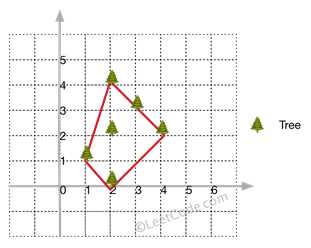
示例 2:
输入: [[1,2],[2,2],[4,2]]
输出: [[1,2],[2,2],[4,2]]
解释:
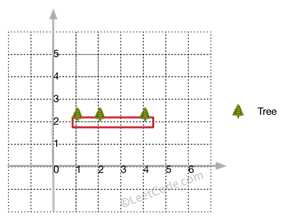
即使树都在一条直线上,你也需要先用绳子包围它们。
注意:
我给了它一个新名字,边界扫描法。用到的性质和解法二密切相关,首先也需要对某个维度进行从小达到排序。这样我们就能确定其中一个顶点了,我们选择横坐标最小的那个点作为整个坐标的原点。
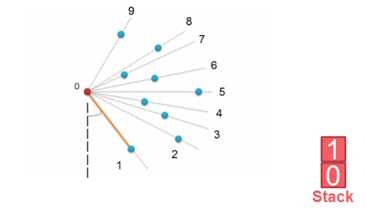

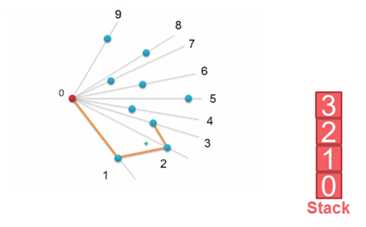
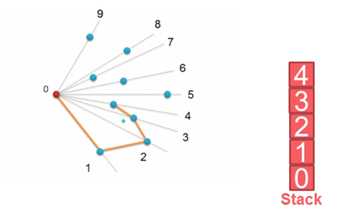
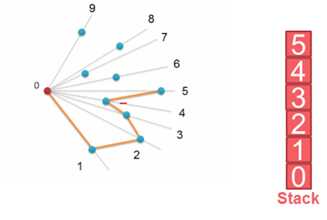
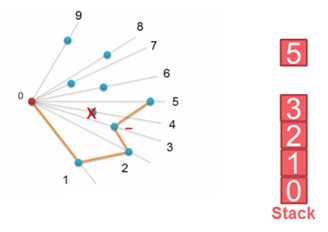
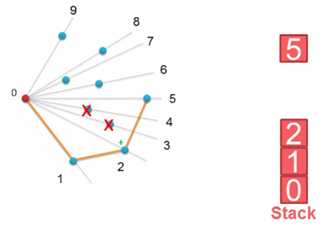
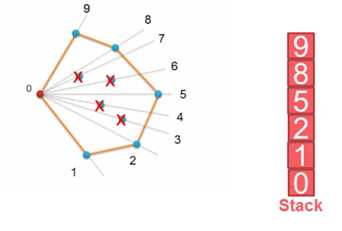
算法步骤:
1. 把所有点放在二维坐标系中,则纵坐标最小的点一定是凸包上的点,如图中的P0。
2. 把所有点的坐标平移一下,使 P0 作为原点,如上图。
3. 计算各个点相对于 P0 的幅角 α ,按从小到大的顺序对各个点排序。当 α 相同时,距离 P0 比较近的排在前面。例如上图得到的结果为 P1,P2,P3,P4,P5,P6,P7,P8。我们由几何知识可以知道,结果中第一个点 P1 和最后一个点 P8 一定是凸包上的点。
(以上是准备步骤,以下开始求凸包)
以上,我们已经知道了凸包上的第一个点 P0 和第二个点 P1,我们把它们放在栈里面。现在从步骤3求得的那个结果里,把 P1 后面的那个点拿出来做当前点,即 P2 。接下来开始找第三个点:
4. 连接P0和栈顶的那个点,得到直线 L 。看当前点是在直线 L 的右边还是左边。如果在直线的右边就执行步骤5;如果在直线上,或者在直线的左边就执行步骤6。
5. 如果在右边,则栈顶的那个元素不是凸包上的点,把栈顶元素出栈。执行步骤4。
6. 当前点是凸包上的点,把它压入栈,执行步骤7。
7. 检查当前的点 P2 是不是步骤3那个结果的最后一个元素。是最后一个元素的话就结束。如果不是的话就把 P2 后面那个点做当前点,返回步骤4。
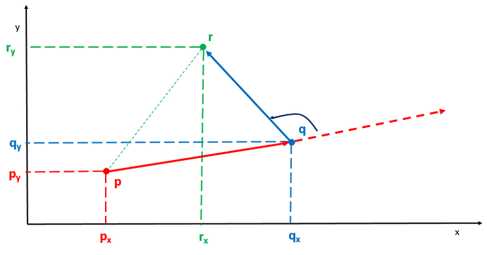
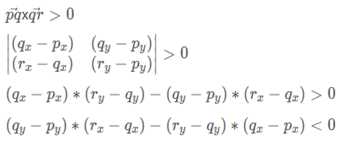
1 public class Solution { 2 public int orientation(Point p, Point q, Point r) { 3 return (q.y - p.y) * (r.x - q.x) - (q.x - p.x) * (r.y - q.y); 4 } 5 public int distance(Point p, Point q) { 6 return (p.x - q.x) * (p.x - q.x) + (p.y - q.y) * (p.y - q.y); 7 } 8 private static Point bottomLeft(Point[] points) { 9 Point bottomLeft = points[0]; 10 for (Point p: points) 11 if (p.y < bottomLeft.y) 12 bottomLeft = p; 13 return bottomLeft; 14 } 15 public List <Point> outerTrees(Point[] points) { 16 if (points.length <= 1) 17 return Arrays.asList(points); 18 Point bm = bottomLeft(points); 19 Arrays.sort(points, new Comparator< Point >() { 20 public int compare(Point p, Point q) { 21 double diff = orientation(bm, p, q) - orientation(bm, q, p); 22 if (diff == 0) 23 return distance(bm, p) - distance(bm, q); 24 else 25 return diff > 0 ? 1 : -1; 26 } 27 }); 28 int i = points.length - 1; 29 while (i >= 0 && orientation(bm, points[points.length - 1], points[i]) == 0) 30 i--; 31 for (int l = i + 1, h = points.length - 1; l < h; l++, h--) { 32 Point temp = points[l]; 33 points[l] = points[h]; 34 points[h] = temp; 35 } 36 Stack < Point > stack = new Stack< >(); 37 stack.push(points[0]); 38 stack.push(points[1]); 39 for (int j = 2; j < points.length; j++) { 40 Point top = stack.pop(); 41 while (orientation(stack.peek(), top, points[j]) > 0) 42 top = stack.pop(); 43 stack.push(top); 44 stack.push(points[j]); 45 } 46 return new ArrayList<>(stack); 47 } 48 }
标签:算法 ati nts 顺序 比较 没有 arraylist ret src
原文地址:https://www.cnblogs.com/kexinxin/p/10381397.html